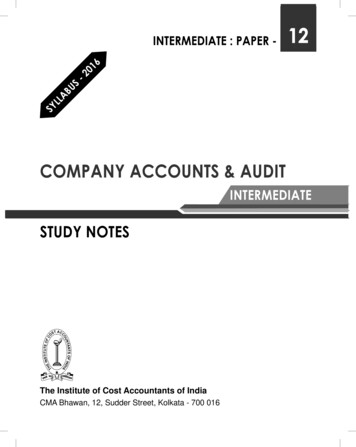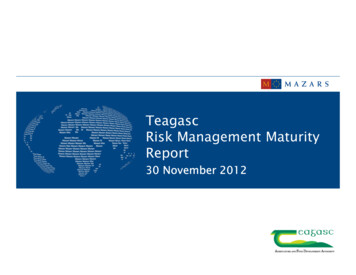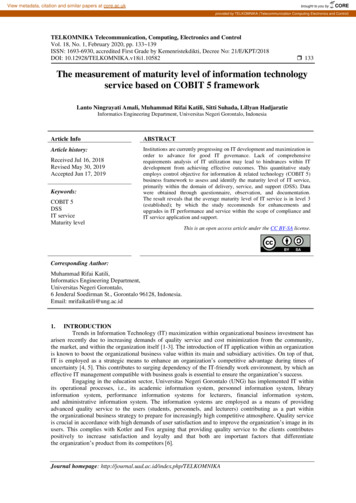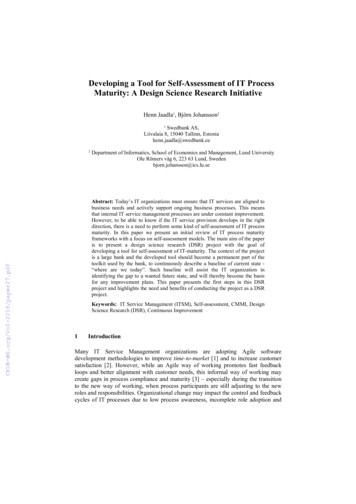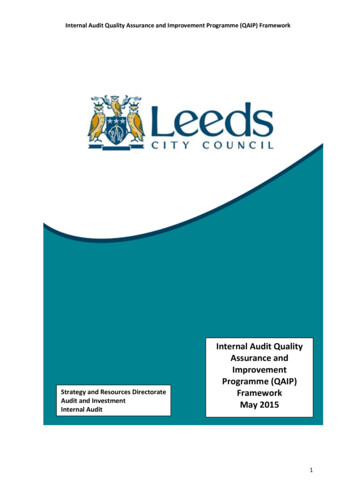
Transcription
ADVISORYTransforming Internal Audit:A Maturity Model fromData Analytics toContinuous Assurancekpmg.ch
ContentsExecutive summary1Making the journey2The value of identifying maturity levels4Internal audit data analytics andcontinuous auditing maturity model5Internal audit plan developmentat various maturity levels6Execution and reporting at various maturity levels9Challenges12Conclusion13
The Maturity Model 1Executive summaryIf you’re traveling down a path that never reaches its destination, would you stay onthe same path or would you try a different approach? It’s a question worth asking,especially when it comes to data analytics-enabled auditing.Although the benefits of data analytics-enabled auditing are well known, many organizations have beenunable to realize them. The primary reasons may lie in their approach. Most organizations take a tactical andtechnical’ approach toward leveraging data analytics in planning and executing audits. This includes buyingsophisticated software tools and hiring specialists to run analytics and expecting that to be sufficient toachieve data analytics-enabled auditing across their audit universe. But to be truly effective and sustainable,data analytics-enabled auditing requires more than proceeding with business-as-usual and adding sometactical and technical data analytic capabilities.While technical skills and tools are surely important to the process, organizations need to take a morestrategic approach to implement, sustain, and expand data analytics-enabled auditing. This may requiretransforming the way you plan, execute, and report audits, including your relationships with businessstakeholders. The key is to focus on your audit methodology, or approach, not just your technical capabilities.This paper provides a multi-dimensional reference model to illustrate how to take a transformative approachtoward audit planning and execution in order to implement sustainable data analytics-enabled auditing.In the examples provided, we’ve modified a traditional internal audit methodology by integrating analyticsand highlighting characteristics throughout each phase. This can help serve as a reference on how andwhere you can modify your internal audit methodology. We’ve then taken it a step further by applying amaturity model as an overlay to the methodology.The maturity model, seen through the lens of an internal audit methodology, is designed to illustratethat there are many data analytics-enabled auditing characteristics across our five phases of an auditmethodology at each of the five proposed maturity levels. As you will see in the following pages, thematurity model serves as a reference to highlight specific data analytics-enabled auditing characteristicsfrom a very basic level of maturity through a very mature level for each phase of the audit methodology.Knowing these characteristics may assist you on your journey to transform your audit methodology, orapproach, to include data analytics in order to reach your desired ultimate internal audit destination.
2 The Maturity ModelMaking the journeyDoes your internal audit approach add value to senior management’s view of business risk and strategicgoals? What role does internal audit play in the assessment of risks that directly impact your organization’sability to achieve its strategic goals? Is the internal audit department a partner in developing the strategicpriorities and vision of the company? Does internal audit’s methodology effectively leverage data analyticsin order to continually assess the risks that would inhibit the achievement of the organization’s strategicgoals? Regarding the risks identified, how does your approach determine how audits are identified, plannedand executed? If the answers to these questions are unclear within your internal audit department, you’recertainly not alone.The continuous assurance of enterprise risk management1 (as noted in Maturity Level V in the chart below)is an ambitious goal for internal audit departments, many of which are still seeking to achieve a state ofintegrated or sustained data analytics, continuous risk assessment and continuous auditing processes. Truthbe told, repeatable and sustainable data analytics and continuous auditing processes remain a top goal formany internal audit departments and senior management, but most organizations are still in their infancy orplanning stages when it comes to actual execution.As internal audit departments seek to advance their approach, the use of a maturity model can helpbenchmark the department, using a few basic characteristics (an example of which can be found on page 6),to provide a clear path toward achieving data analytics-enabled internal auditing, continuous auditing, andbeyond. Rooted in an internal audit methodology, the maturity model serves as a guide along the journeyfrom traditional internal audit models toward more mature levels of continuous auditing, and through to thecontinuous assurance of enterprise risk management – an ultimate goal of internal audit, as well as, mostenterprises and their executive management. A key first step within the maturity model is the successfulintegration of data analytics.An overview of maturity levelsThe maturity model below represents the stages of maturity from the least mature state of traditionalauditing through to the most mature state of continuous assurance of enterprise risk management.Least MatureMost MatureMaturityLevel IMaturityLevel IITraditionalAuditingAd HocIntegratedAnalyticsMaturityLevel IIIContinuous RiskAssessment &ContinuousAuditingMaturityLevel IVIntegratedContinuousAuditing &ContinuousMonitoringMaturityLevel VContinuousAssurance ofEnterprise RiskManagement Continuous Assurance is a progressive shift in audit practices towards the maximum possible degree of auditautomation as a way of taking advantage of the technological basis of the modern entity in order to reduce auditcosts and increase audit automation. Given the emphasis on the transformation of the entire system of auditing,the development of Continuous Assurance requires a fundamental rethink of all aspects of auditing, from the wayin which data is made available to the auditor, to the kinds of tests the auditor conducts, how abnormalities aredealt with, what kinds of reports are issued, how often and to whom they are issued, and many other factors, theimportance of some of which will only become apparent as Continuous Assurance is implemented.“Continuous Assurance for the Now Economy”, Rutgers Business School, February 2010.1
While many internal audit departments may have already added the use of data analytics in the planning,scoping, and execution of audits, many have done so in an ad hoc fashion – using one or two technicalresources for one or more isolated areas of audit focus. As a result, these internal audit departments arejust skimming the surface and are underutilizing the full potential of data analytics by failing to radiate thispowerful capability across their departments and their audit universe.Here lies the fundamental problem. Most organizations have not considered the use of data analytics orcontinuous auditing in relation to the department’s internal audit methodology, including a transformationof how audits are planned, executed, and reported. For example, most internal audit methodologies do notconnect or integrate the use of data analytics or continuous auditing throughout the various phases of anaudit cycle. Hence, data analytics becomes more of a bolt-on activity, which departments try to sustain bybuilding a ”technical” capability, rather than a strategic enabler integrated into the fabric of the audit process.By not integrating data analytics within the internal audit process to guide the department in planning andexecuting audits, internal audit departments struggle with implementing the use of data analytics. Even ifthey have implemented its use, those same departments have struggled with expanding its use beyond oneor two resources, beyond one or two audit areas, or beyond use on an infrequent basis. Further, when itsuse is concentrated with one or two key resources, and those resources leave the department, use of dataanalytics frequently stops. Consequently, the results generated from traditional ad hoc analytics ultimatelydo not have a significant impact on the departments’ audit approach because of this lack of integration intothe overall audit process.As a result, there continues to be a barrier in the way that internal audit departments are leveragingdata analytics, which can be overcome by fundamentally transforming the audit process via a new auditapproach, or methodology. A maturity path may help to effectively initiate and advance the use of dataanalytics and continuous auditing.By starting with the phases of a common internal audit methodology and identifying the characteristics atdifferent levels of maturity, an organization can identify logical integration points for repeatable and sustainabledata analytics, continuous auditing, and other related initiatives. The result is a new internal audit methodologyadapted to represent data analytics-enabled internal auditing at each phase of the audit process.By starting with the phases of a commoninternal audit methodology and identifyingthe characteristics at different levels ofmaturity, an organization can identifylogical integration points for repeatableand sustainable data analytics, continuousauditing, and other related initiatives.
4 The Maturity ModelThe value of identifying maturity levelsThe first step on your transformation journey toward achieving data analytics-enabled auditing involvesidentifying your current level of maturity. Knowing your current maturity level is necessary to determinegaps within the approach that need to be addressed in order to reach the desired future state. Not everyorganization requires the same level of maturity in their data analytics or continuous auditing processes.It depends on a number of factors including, for example, the needs and goals of the enterprise, theambitions and permissions of the chief audit executive, the nature of the enterprise’s business, and theregulatory environment in which the enterprise operates now and in the future.Establishing where your internal audit organization stands requires comparison with a reference maturitymodel, which includes clear levels of maturity, for each phase of the audit process, with consideration of avariety of people, process, and technology factors. The purpose of such a comparison, or gap assessment,is to help identify the desired future state maturity level that is right for your internal audit organization, thegaps between the current and future states, and to enable building a strategy to achieve the desired futurematurity state. Moreover, the model serves as a mechanism to measure progress along the way.KPMG has developed the following reference maturity model to illustrate the application of data analyticsand their related characteristics for each phase of the audit methodology and how they may vary at differentmaturity levels.
The Maturity Model 5Internal audit data analytics andcontinuous auditing maturity modelAudit Methodology-based Maturity ModelMaturity LevelsIAMethodologyLevel ITraditionalAuditingLevel IILevel IIILevel IVLevel VAd HocIntegratedAnalyticsContinuousRiskAssessment &ContinuousAuditingIntegratedContinuousAuditing &ContinuousMonitoringContinuousAssuranceof trategicAnalysisEnterprise RiskAssessmentInternalAudit PlanDevelopmentExecution andReportingContinuousImprovementTypes of DataAnalyticsApplicableDescriptiveData Analytics are generally not usedDescriptive,DiagnosticData Analytics are partially used butare sub-optimizedData Analytics are effectively andconsistently used (optimized)Many organizations have an interest in expanding data analytics and moving beyond the traditional auditing process toward repeatable andsustainable data analytics-enabled auditing, quantitative-based continuous risk assessment for dynamic audit planning and continuousauditing. Others may seek additional value through the integration of continuous auditing and continuous monitoring functions. And thetruly ambitious will go further and seek to achieve full maturity to achieve the continuous assurance of enterprise risk management.The authors do not mean to suggest that CA needs to be in place before or in order for CM to be in place. CM can be implemented bymanagement independent of internal audit. However, if both CA and CM are in place, they should be integrated – which is the focus ofMaturity Level IV.Using the maturity model to lay the groundwork, an internal audit organization will need to evaluate itscurrent internal audit methodology for audit planning, execution, and reporting. The early phases of a typicalinternal audit methodology should include strategic analysis and enterprise risk assessment. Strategicanalysis provides an initial understanding of an organization’s business from a top-down perspective andoffers a framework to help identify organizational and industry issues, strategic objectives and challenges.Next, an enterprise risk assessment is necessary to gain insight into the risks that may threaten a company’sachievement of business and strategic objectives.For illustrative purposes, we are focusing the following pages on two select phases of the internal auditmethodology – internal audit plan development and execution and reporting – to highlight the application of,and characteristics relating to the integration of, data analytics within the reference maturity model.
6 The Maturity ModelInternal audit plan development atvarious maturity levelsInternal audit plan development should be based on the prioritization of the risks identified during theenterprise risk assessment phase of an audit methodology. Internal audit plan development involvesdefining the operational, financial and strategic risks that need to be addressed through the execution of theinternal audit plan, including the approximate resources necessary to accomplish the scope, and providesa basis for an organization to monitor progress and performance. The use of analytics-enabled auditingcharacteristics at this phase increases as you move from a very basic level of maturity (Maturity Level I)through to a very mature level (Maturity Level V) as represented in the chart below.InternalAudit DataAnalytics andContinuousAuditingMaturityModelInternalAudit PlanDevelopmentMaturityLevel ITraditionalAuditing Limited useof descriptivedata analyticsMaturityLevel IIAd HocIntegratedAnalytics Use ofmanagementreportingunderlyingdata toperform broaddescriptive dataanalytics (i.e.benchmarking) Use ofanalyticsmay includedescriptiveand somediagnosticMaturityLevel IIIMaturityLevel IVMaturityLevel VContinuousRiskAssessment &ContinuousAuditingIntegratedContinuousAuditing &ContinuousMonitoringContinuousAssurance ofEnterprise RiskManagement A predefinedset of analyticsis establishedto identify andprioritize risk Managementsystems areleveragedto enablecontinuousassessment andprioritization ofbusiness risks TheEnterprises’strategic goaland objectivesare alignedwith riskmanagementpractices Systemgeneratedanalytics anddashboardsare monitoredby thebusinessagainstspecifiedrisk criteria Strategicobjectives andrisks to thoseobjectives aremonitored andprioritized ona continuousbasis Automatedextract,transform,and load (ETL),analytics andreporting Use ofanalyticsmay includeprescriptive,diagnostic,and somepredictive Predictive andprescriptiveanalytics maybe added tothe descriptiveand diagnostic IA Plan isdynamic andable to react tochanges in thebusiness Consistent useof e andprescriptive
The Maturity Model 7Internal Audit Plan Development at Maturity Levels I and IIIn traditional internal audit methodologies (Maturity Level I), data analytics are not typically utilized todevelop the audit plan. At the next maturity level of ad hoc analytics (Maturity Level II), internal audit mayuse some high level quantitative measures, such as financial statement trends and industry benchmarking,in conjunction with the traditional qualitative approach. The quantitative measures are utilized to confirm andvalidate the risks and areas of focus identified during the qualitative/traditional planning process. This type ofidentification and prioritization typically occurs on an annual basis.Internal Audit Plan Development at Maturity Level IIIDuring the third maturity level of continuous risk assessment and continuous auditing (Maturity Level III), internalaudit monitors a number of quantitative measures that provide insights to changes in the business, controlweaknesses and business performance. The quantitative and qualitative measures are aligned with prioritybusiness risks and internal audit evaluates these quantitative and qualitative measures regularly throughoutthe year on a quarterly or monthly basis. Business risks and audit areas are re-prioritized in accordance with thebusiness risk profile. In addition, the assurance of risk appetite2 and coverage is further refined and enhancedusing data analytics. The types of analytics used may include descriptive, diagnostic and even some predictive.The analytics utilized identify risks that are outside of established risk appetite parameters and the analysisis performed more frequently at determined time intervals. At this third maturity level, evolving events in theregulatory and risk environment are considered near real time for impact to the business and for businessresponse to the change in the environment.Internal Audit Plan Development at Maturity Level IVThe next maturity level to consider is continuous auditing and continuous monitoring (Maturity Level IV).At this fourth maturity level, project planning during internal plan development involves many key businessprocesses that leverage business intelligence and continuous monitoring techniques to evaluate businessrisk and financial and operational results. Analytics include both internal and external data and results arebenchmarked against leading practices. Internal audit leverages the business’ continuous monitoring processand output to identify audit trigger events and re-prioritize risks at appropriate intervals (e.g., monthly, quarterly,etc.). The assurance of risk appetite and coverage is further refined and enhanced using data analytics.Predictive analytics may be used more extensively and prescriptive analytics may be introduced. Data analyticsare system generated from within the business units to enable audits to be added, accelerated, dropped,or deferred (i.e., dynamic audit planning). Audit plans are dynamically created using a number of variables,including key performance indicators (KPIs), key risk indicators (KRIs), and historical results prior audits.Internal Audit Plan Development at Maturity Level VIn the ultimate maturity level of continuous assurance of enterprise risk management (Maturity Level V),internal audit plan development would involve the monitoring of an enterprise’s strategic and business processrisks using business intelligence and continuous monitoring techniques. The risks and performance indicatorsare continuously reconciled to an enterprise’s strategic business objectives. The strategic risk factors includeboth internal and external factors that may inhibit the achievement of the strategy and the analysis of thechanges in risk drives the prioritization of audit areas on a continuous basis at predetermined intervals(e.g., daily, weekly, monthly, etc.). This level of maturity is characterized by a more expansive and consistentuse of advanced analytics including predictive and prescriptive analytics. Risk appetite is generally regarded as the amount of risk that a company is willing to assume over a period of time and in the pursuit of itsmission, Turning Risk into Advantage: A Case Study, KPMG LLP (2011)2
8 The Maturity ModelDefining analytic capabilitiesAnalytical capabilities can be defined and organized into the following four categories of capability: Descriptive,Diagnostic, Predictive and Prescriptive. You will need to manage the capabilities as a portfolio. See "AdvancedAnalytics: Predictive, Collaborative and Pervasive."Descriptive analytical capabilities: Descriptive analysis/models provide information about the state of events,trends, patterns and relationships in the existing data and provide the basis for models which may be used tofind variance to patterns in new data. (Note: With descriptive models, there is no response [dependent] variablethat you are trying to predict the value of.) The typical kind of analytic question answered is "What happened orwhat is happening right now and how does it relate to historical patterns?"Diagnostic analytical capabilities: These types of analysis are developed to understand the causes of anoutcome, often in the context of a process or related events. Various techniques and models can be usedto abstract and account for dependencies among causal factors. Typical kinds of insight provide by this sortof analysis include answers to the business question "Why did it happen?"Predictive analytical capabilities: These types of analysis are developed for predicting the values ofone or more response (dependent) variables from the values of predictor (independent) variables in thedataset. Predictive models use historical data with known responses to develop (or estimate) a modelthat can be used to predict values for new data. These sorts of capability are needed to supportleading performance measures: e.g., "What will happen?" and "What is likely to happen?"Prescriptive analytical capabilities: Prescriptive models and analysis are used to develop acourse of action (adaptation) in response to an event or series of events. A prescriptive model canbe used to define and articulate the ideal process to follow to address or respond to an event.Given that a certain action or event has taken place, the prescriptive model can be used to findthe best response. This kind of analysis can answer business questions such as "What is therecommended next action?"Source: Best Practices in Analytics: Integrating Analytical Capabilities andProcess Flows, Gartner, March 2012
The Maturity Model 9Execution and reporting at variousmaturity levelsWithin an internal audit methodology, execution and reporting involves the scoping of each audit, creatingand executing the audit steps, conducting the business process analysis, identification of control gaps to beconsidered or evaluated, and the documentation of audit evidence and reporting of any findings. The use ofanalytics-enabled auditing characteristics at this phase increases as you move up from each of the five maturitylevels as shown in the chart below.Internal AuditData Analyticsand ContinuousAuditingMaturity ModelExecution andReportingMaturityLevel ITraditionalAuditing Data Analyticsare not utilizedto drive theexecution ofthe audit planin traditionalauditingMaturityLevel IIMaturityLevel IIIAd HocIntegratedAnalyticsContinuousRiskAssessment &ContinuousAuditingIntegratedContinuousAuditing &ContinuousMonitoring Key businessprocesseshaveautomatedanalytics readyfor the auditorduring planningto scopeand focusaudit efforts. AutomatedAuditingtechniquesachieveseveral auditobjectivesbased on“exception”auditing. Ad hoc dataanalyticsare utilizedto identifyoutlyingtransactionsor to assistin scopingthe audit. Use ofanalyticsmay includedescriptiveand somediagnostic Data analyticenabled auditprograms Use ofanalyticsmay includeprescriptive,diagnostic,and somepredictiveMaturityLevel IV Internal Auditis connectedto the samedata andreporting asmanagementand assessesthe quality ofthe data andthe analyticsmonitored bythe business.MaturityLevel VContinuousAssuranceof EnterpriseRiskManagement Auditproceduresare designedto verify theunderlyingdata analysisand reportingof risk at thebusiness levelto ensurethat they arealigned withthe Enterprisestrategic goalsand objectives. Automatedauditing isfocused onroot causeanalysis andmanagement’sresponses to Predictive andrisks includingprescriptivebusinessanalytics mayanomalies andbe added totrigger events.the descriptiveand diagnostic Consistent useof e andprescriptive
10 The Maturity ModelExecution and Reporting at Maturity Levels I and IIThis phase of an internal audit methodology is focused on the identification and communication offindings and performance improvement opportunities using formal documentation and meetings withvarious constituent groups such as the audit committee, senior management, process owners, and otherstakeholders to communicate the results of the internal audit work. This drives change that contributeto the achievement of the enterprise’s strategic and business objectives. During the execution andreporting phase, auditors typically review financial statements, management reporting, prior audit reports,performance and risk indicators affected by the process to gain an understanding of the business process.In traditional auditing (Maturity Level I), data analytics are generally not utilized to drive the execution ofthe audit plan. In Maturity Level II, ad hoc data analytics help to identify outlier transactions and focus auditscope. The analytics are descriptive in nature and their results guide the walkthrough procedures focusingon identified gaps, and the prioritization of the measure and analyze procedures.Execution and Reporting at Maturity Level IIIExecution and reporting at the continuous risk assessment and continuous auditing maturity level(Maturity Level III) would include key business processes with automated analytics generated forthe auditor during planning in order to scope and focus audit efforts.As part of the execution and reporting methodology phase, internal audit actively reviews performance and riskindicators, benchmark comparisons and external information. Data is readily available, analytics are descriptive,diagnostic, and even some predictive with some analytics being pre-packaged. The analytic results focus thewalkthrough procedures and the prioritization of measure and analyze procedures. Internal audit utilizes dataanalytics-enabled audit programs to expand audit coverage and improve auditing efficiency and effectiveness.Most data is readily available to the auditor and is validated during audit execution. Root cause is investigatedthrough the data and verified by inquiry. The data and results are available and verified by the businessprocess owners.Execution and Reporting at Maturity Level IVIn Maturity Level IV (integrated continuous auditing and continuous monitoring), the business processowners monitor performance and risk indicators for the business processes during project planning.The audit team leverages the business’ monitoring and performs independent analyses on the monitoringoutput to identify trends and prioritize areas to focus audit efforts.Internal audit is now connected to the same data and reporting as management. Internal audit assessesthe data quality and the analytics monitored by the business. Continuing with the process analysis areaof the execution and reporting phase as an example, internal audit performs analyses of the resultsfrom management’s monitoring process to gain an understanding of how well risks are monitoredand controlled. System event logs and process sequencing are analyzed. In addition to descriptive anddiagnostic analytics, predictive analytics may be used more extensively, prescriptive analytics maybe introduced, and the analytics may be programmed or even automated. (see sidebar on page xx)The analytic results guide walkthrough procedures and the prioritization of the measure andanalyze procedures.
The Maturity Model 11Internal audit can then leverage the analytics and monitoring performed by the business and data quality isregularly validated. Automated auditing techniques achieve several audit objectives based on “exception”auditing. This type of auditing is performed on a continuous basis rather than only when an audit is scheduled.These audit programs allow internal audit to gain increasing efficiencies and to expand audit coverage. The auditteam interprets, analyzes, and challenges the results of the analytics. The root cause is investigated through thedata and verified by management through inquiry and the exceptions and results are verified by the businessprocess owners.Execution and Reporting at Maturity Level VThe next maturity level, which can be viewed as the ultimate objective of internal audit organizations, is thecontinuous assurance of enterprise risk management (Maturity Level V ). The execution and reportingmethodology phase at this level includes project planning in which business monitoring and audit’s proceduresrely on the same processes, technology, data and information. The auditor performs procedures verifying theunderlying data analytics and reporting are aligned with the strategic objectives.The audit scope is fluid, focusing on root cause analysis and management’seffectiveness at monitoring and responding to risks.Continuing to look at process analysis as an example, at this maturity level,process analysis involves data analytics that are executed by the enterprise’ssystems to continuously verify that certain risk tolerances are not exceeded.This level of maturity is characterized by a more expansive and consistentuse of advanced analytics including predictive and prescriptive analytics.The business risks are reconciled to the entity level key strategic risks ona continuous basis. A technology-enabled process analyzes internal andexter
maturity model as an overlay to the methodology. The maturity model, seen through the lens of an internal audit methodology, is designed to illustrate that there are many data analytics-enabled auditing characteristics across our five phases of an audit methodology at each of the five proposed maturity levels.


